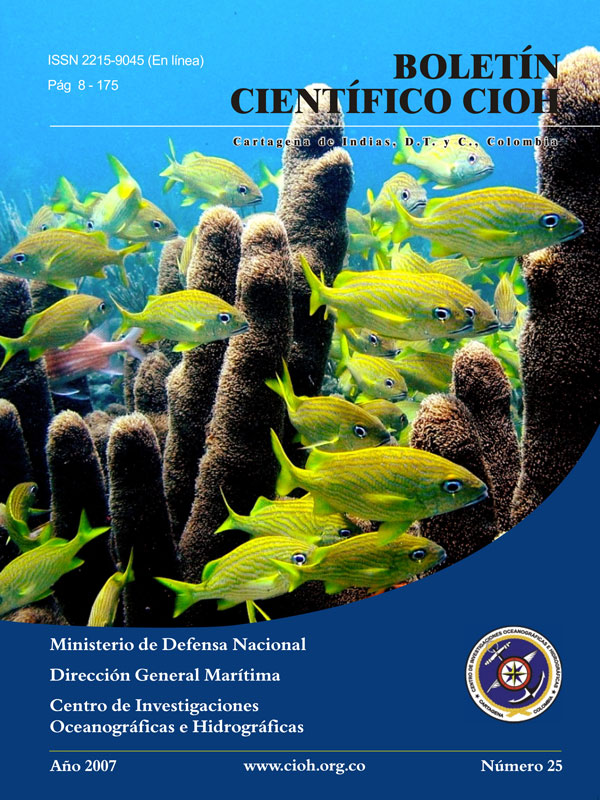Swell propagation and assimilation of satellite data in a third generation spectral model
DOI:
https://doi.org/10.26640/22159045.160Keywords:
Spectral wave model, data assimilation, numerical scheme of transportAbstract
In wave forecasting in the Caribbean, two ways to improve enhancing of model accuracy are possible: improvement of the numerical scheme of transport of the wave spectrum, and an appropriate assimilation of the data obtained from the satellite platforms. The former minimizes the wind wave propagation error along the fetch and increases the swell estimate accuracy. Several numerical schemes are analyzed, such as Lax-Vendroff, FCT, TVD, “upward” of the first order of approximation and a non-central scheme of the third order. Despite the fact that the type TVD positive schemes, keep the initial form of perturbations best, the greater accuracy in the integral spectrum conservation was found by using the scheme of the third order. After the implementation of that algorithm, a non-traditional methodology is proposed to assimilate data from the JASON-1 orbits. The methodology is based on the small perturbations theory for a functional which minimizes the model mean square error, correcting some constants responsible for physical processes description of generation, dissipation and non-linear spectral transformation.Downloads
References
[2] Tolman HL.(2002). Testing of WAVE WATCH III version 2.22 in NCEP's NWW3 ocean wave model suite. Tech. Note 214, NOAA/NWS/NCEP/OMB, 99p.
[3] SWAN. (2007). Technical Documentation. Delft University of Technology, Version 40.51 A, 111p.
[4] Fletcher CAJ. (1988). Computational Techniques for Fluid Dynamics, Vol 1 & 2. Springer-Verlag, Berlin.
[5] Thubum J.(1997). TVD Schemes, Positive Schemes, and the Universal Limiter. Monthly Weather Review, Vol.125, pp. 1990 - 1993.
[6] Tolman HL. (2002). Alleviation the Garden Sprinkler Effect in wind wave models. Ocean Modelling, 4, pp. 269-289.
[7] Thomas J. (1988). Retrieval of energy spectra from measured data for assimilation in to a wave model. Q. J. R. Meteorol. Soc., 114, pp. 781-800.
[8] Lionello P, H Gunther and PAEM Janssen.(1992). Assimilation of altimeter data in a global third generation wave model. J. Geophys. Res. C97,14453-14474.
[9] Bauer E, K Hasselmann, I Youngand S Hasselmann.(1996). Assimilation of wave data into the wave model WAM using an impulse response function method. J. Geophys. Res. 101, C2, 3801-3816.
[10] Emmanouil G, Galanis G, Kallos G, Breivik LA, Heiberg H & Reistad M.(2007). Assimilation of radar altimeter data in numerical wave models: an impact study in two different wave climate regions. Ann. Geophys., 25, pp. 581-595.
[11] Lonin S A y López L A.(2003). Comparación de los pronósticos de UKMO y MM5 para su utilización en el sistema de pronóstico oceanógrafico del Caribe. Boletín Científico CIOH, N. 21, pp. 51-65.
[12] ARW.(2002). Modeling System User's Guide. Versión 2. NCEP, NOAA.
[13] Lonin S A, IE Lonina y Yu S Tuchkovenko.(1996). Utilización del modelo NedWAM para el cálculo y pronóstico del oleaje en el Mar Caribe. Boletín Científico CIOH, No. 17, Cartagena, pp. 37-46.
[14] Boris J P & D L Book.(1973). Flux corrected transport. I: SHASTA, a fluid transport algorithm that works. J. Comput. Phys., 11, pp. 38-69.
[15] Harten A.(1983). High resolution schemes for hyperbolic conservation laws. J. Comput. Phys., 49, pp. 357-393.
[16] Roache P J. (1972). Computacional Fluid Dynamics. Albuquerque, N. M.: Hermosa.
[17] Roe PL. (1986). Ann. Rev. Fluid Mech., 18, pp. 337-365.
[18] Marchuk GI.(1974). Solución numérica de los problemas de dinámica de la atmósfera y el océano. Leningrado, Gidrometeoizdat, 303 p. (en ruso).
[19] Torres R y Lonin S.(2007). Construcción de espectros de oleaje en el Caribe a partir de mediciones satelitales. Boletín Científico CIOH, No. 25. En publicación.
[20] Torres R y Lonin S.(2007). Estudio preliminar del espectro de oleaje en el Caribe observado con boyas y su representación en el espectro JONSWAP. Boletín Científico CIOH, No. 25. En publicación.
[21] Hunsdorfer W, B Koren, M van Loon & J G Verwet. (1995). A positive finite-difference advection scheme. J. Comput. Phys., 117, pp. 35-46.
[22] van Leer B.(1974). Toward the ultimate conservative difference scheme. II: Monotonicity and conservation combined in a second order scheme. J. Comput. Phys., 14, pp. 361-370.
[23] Hasselmann K, T Barnett, E Bouws, H Carlson, D Cartwright, K Enke, J Ewing,H Gienapp, D Hasselmann, P Kruseman, A Meerburg, P Muller, DO lbers, K Richter, W Selland H Walden (1973). Measurements of wind-wave grow thand swell decay during the Joint North Sea Wave Project (JONSWAP), Dtsch. Hydrogr. Z. Suppl. A 8(12), 95p.
Downloads
Published
Issue
Section
License
Attribution — You must give appropriate credit, provide a link to the license, and indicate if changes were made. You may do so in any reasonable manner, but not in any way that suggests the licensor endorses you or your use.
NonCommercial — You may not use the material for commercial purposes.
NoDerivatives — If you remix, transform, or build upon the material, you may not distribute the modified material.
No additional restrictions — You may not apply legal terms or technological measures that legally restrict others from doing anything the license permits.



